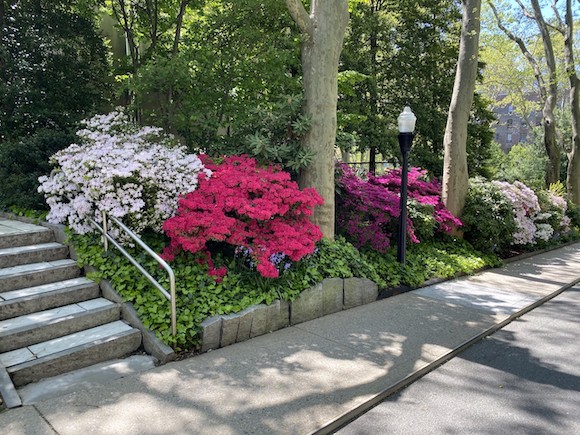This message was sent to the Rockefeller community from the Office of the President on May 14, 2020 at 1:06 p.m.
Subject: COVID-19 update from the president

Dear colleagues,
Greetings. I hope all continues well with you and your families. May has brought modest hints of warmer weather, along with strong signs of renewal to campus, with a brood of ducklings in the Philosopher’s Garden ponds and the blooming of the azaleas (see below).
The metrics of the COVID-19 pandemic continue to show improvement in NYC and on campus. The number of new hospitalizations, the daily death toll and the fraction of viral RNA tests that are positive in the city continue to decline, with the latter now less than 10% in all the boroughs, compared to >50% in late March. This is reflected on campus as well, where the number of people on the Occupational Health Service’s ‘in isolation’ list is down to 5 today. The university community’s overall status reflects great support by OHS, along with everyone’s diligence and adherence to frequent handwashing, wearing masks, social distancing, and only leaving home when necessary.
Nonetheless, I’m very sad to report that our wider community has been hard-hit by the pandemic. Luis Figueroa, a beloved member of the Sutton Terrace building staff who worked there as a porter for over 20 years, passed away from complications of COVID-19 on May 7 after a five-week battle. He was a regular presence in the lives of many Rockefeller families, and he will be fondly remembered and missed.
The improving conditions in NY state will lead to the opening of some construction and manufacturing in regions of the state that have had very few COVID-19 cases and meet criteria established by the governor relating to the number of new cases, hospitalizations, and deaths; the ability of the hospital system to handle a surge in cases; and the ability to adequately test for SARS-CoV-2 and trace contacts. I think these criteria establish an appropriately cautious approach to reopening, meant to guard against a new surge in cases. New York City does not yet meet all these criteria and will remain on a stay-at-home order through at least the end of May; Rockefeller will follow this guidance. During the coming weeks, we are continuing to plan for our phased reopening and are closely tracking progress toward the reopening criteria announced by the governor. Our goal is to gradually restart our laboratory research programs with a focus on sustaining the health of our community.
Over the last month I participated in discussions among a small group of scientists convened by Harold Varmus to consider some of the public health issues and unresolved scientific questions that will need to be addressed in order to reopen society. One of our key conclusions was the need to rethink our current models for testing for infection, which were not developed envisioning the scale that is now required, which we conservatively estimated as 2 million per day. The current centralized testing instruments are too costly, too slow, don’t scale to the level needed, and aren’t focused at local points of care or workplaces. We expressed concern that a rush to reopen the economy with too little testing and contact tracing will prolong the pandemic and slow economic recovery, and addressed other unanswered questions. An article summarizing some of our thoughts was published last Saturday in The Atlantic.
Our COVID-19 research continues to make rapid progress. Michel Nussenzweig’s group has cloned the genes that produce potent neutralizing antibodies that can prevent viral infection; these are moving toward clinical trials, the result of a terrific collaboration that includes the hospital, Paul Bieniasz, Theodora Hatziioannou, and Charlie Rice. Tarun Kapoor’s team has identified promising leads for small molecule inhibitors of the viral helicase that is required for viral replication; these are entering medicinal chemistry at the Tri-Institutional Therapeutic Discovery Institute. Tom Tuschl’s lab is identifying inhibitors of the viral protease required for productive infection. Jean-Laurent Casanova is identifying mutations in the genomes of patients with severe clinical courses. On the clinical side, Bob Darnell’s lab and an intrepid group of graduate students are scaling up on-campus viral testing capacity, hoping to provide regular screening on campus.
The last week has also brought the recognition of a rare syndrome featuring inflammation of blood vessels in children who have been infected with COVID-19. The timing of this syndrome, typically occurring late in the course of infection or after recovery, suggests the immune response to the virus may play a role. Jean-Laurent’s research on genetic determinants of infectious disease may be relevant to this condition, and he has joined forces with the New York Genome Center and the New York State Department of Health to look for inherited susceptibility to this complication. Governor Cuomo touted this collaboration at his May 8 daily briefing.
Lastly, I want to share some joyous news that is a wonderful expression of optimism for the future. Amy Shyer and Alan Rodrigues have announced that their second child, Orson Byrd Rodrigues, was born on May 2. This adds to the bevy of births in our community in the last few months, which includes Lucas, the first child of Li Zhao and Nicolas Svetec; Viviana Risca’s and Tom Eliaz’s first-born, Adrian; and twins—Raphaela and Friederkie—born to Winrich Freiwald and Victoria Swire Yoffie, on March 30. Congratulations to these and other new parents in our community. We look forward to emerging from this crisis stronger, and building a safer, healthier world for your children.
With all best wishes,
Rick
Richard P. Lifton, M.D., Ph.D.
Carson Family Professor
Laboratory of Human Genetics and Genomics
President
The Rockefeller University
